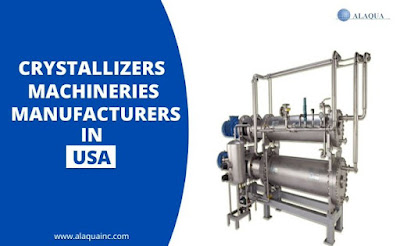What are the chemical Fundamentals of Industrial Crystallization?
Industrial crystallization methods are designed to produce
crystalline. Items on a large scale by forming a suspension of increasing
particles in a solution. Product quality is influenced by the type of
crystalline phase created. Crystal size distribution, crystal shape, and
product purity. These product quality characteristics are defined by crystallization
sub-processes. The most essential of which is crystal nucleation and growth.
The driving force for these sub-processes is often established by chilling. The
solution to reducing solubility or evaporates the solvent to raise
concentration. The new interest in continuous crystallization techniques in
pharmaceutical. Research is bolstered by promises of increased product quality.
More efficient use of materials and energy resources, and reduced waste
streams. Alaqua is USA-based processing equipment including crystallizers supplier worldwide.
Industrial crystallization fundamentals and uses in the
industry
The formation of a solid in which the atoms or molecules. The
highly organized into a crystal structure is known as crystallization. Crystals
form in a variety of mechanisms, including precipitation from a solution,
freezing. In rare cases, direct deposition from gas. Temperature, air
pressure, and, in the case of liquid crystals. The evaporation duration, are
all factors to consider.
Are all important elements in determining the properties of
the final crystal?
Crystallization occurs in two steps. Nucleation is the
formation of a crystalline phase from a supercoiled liquid or a supersaturated
solvent. The second step is crystal growth or the increase in particle size
that leads to the crystal state. A fundamental feature of this stage is the
creation of layers. The crystal's surface by loose particles that lodge
themselves in open imperfections such as holes. Fissures, and so on.
Crystallization Precipitation and crystallizers supplier
The majority of organic minerals and molecules crystallize
readily. The resultant crystals are of excellent quality, that is, free of
obvious flaws. Larger biological particles, such as proteins, are on the other
hand. Difficult to crystallize. The intensity of either intermolecular forces
(organic and biochemical substances). Atomic forces (in the case of mineral substances).
Or intermolecular forces (in the case of organic and biochemical substances)
influence the ease with. Which molecules condense (biochemical substances)?
When a solute is a mass transferred from a liquid solution to
a pure solid crystalline phase. Crystallization is a chemical solid-liquid
separation process. Crystallization is accomplished in a crystallizer in chemical engineering. As a result, crystallization
is connected to precipitation. Even if the end product is neither disordered
nor amorphous.
Why are Crystallization Important and distillation equipment
services?
Nucleation and crystal development are two main stages in the
crystallization process. Both of which are influenced by physics and chemical
characteristics. When crystallization takes place. Nucleation is the process by
which substance molecules or atoms dispersed in a solvent begin to combine into
clusters. Raising substance concentration in a small area on a microscopic
scale. And becoming stable under current operating circumstances. Nuclei are
represented as stable clusters. As a result, to become stable nuclei, the
clusters must grow to a certain size. The atoms or molecules prepare in a
defined and periodic manner during the nucleation stage. Which determines the
crystal structure.
Many substances may crystallize. With some having completely
diverse crystal forms, a phenomenon known as polymorphism. Bound polymorphs may
also have stability. Which indicates that even if it isn't in thermodynamic
equilibrium. it is kinetically stable and requires some energy input to change
the equilibrium component. Every organism is a thermodynamic solid-state. Crystal
polymorphs of the same chemical have distinct physical features such as
dissolution rate. Shape (angles between sides and aspect growth rates),
temperature, and so on. As a result, polymorphism is critical in the commercial
fabrication of crystalline products. Furthermore, changeable variables such as
temperature can cause crystal phases to interconvert. As shown in the transition
of anatine to oxide mineral phases. Crystals may be classified into two
categories, an action and an anion known as a salt, being the first, such as
sodium acetate. Uncharged species, such as menthol, make up the second class of
crystals.
Top Common Crystallization Parameters & Transformations
Crystal formation can be accomplished in a variety of
methods, including cooling. Evaporation, adding a second solvent to lower the
substance's solubility (a process known as ant solvent or drown-out). Solvent
layering, and sublimation, as well as dynamic action or anion production.
The production of a supersaturated solution does not ensure
the development of crystals. And nucleation sites are frequently formed by
using a seed crystal or scratching the glass.
A common laboratory method for crystal formation is to
dissolve the material in a very soluble solution. Often at extremely high
temperatures to achieve supersaturation. After that, any insoluble
contaminants are removed from the new mixture by filtering. Allow for a gentle
cooling of the filtrate. The crystals are washed and filtered with a solvent
that isn't soluble but mixable with the mother liquor. In a procedure known as
recrystallization. The operation is then repeated to increase the purity.
Case Study: Crystallization Cooling Rates with crystallization
Small batch crystallization below the oil. Vapor diffusion
techniques have been the most frequent way for biological molecules. With
solvent channels still present to keep the three-dimensional structure intact.
Alaqua is processing equipment such as the evaporator. Solvent
recovery, spray dryer, distillation, heat exchanger, crystallizers. Supplier in
the USA that supplies this processing equipment worldwide. Along with supplying
processing equipment, they also offer installation and commissioning. Equipment
fabrication, retrofitting, troubleshooting, personnel training, and field
services for the processing equipment. Visit them today for further queries and
information!





